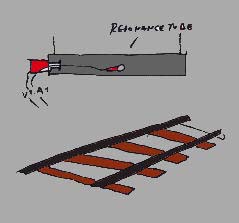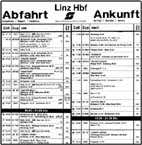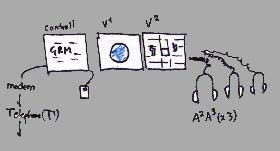MAXRES O+A 95
Is an installation by Bruce Odland and Sam Auinger which links the Linzer Haupt- bahnhof with the Brucknerhaus in a harmonic and melodic interface of man machine and information. The ambient sound of the train station is re-tuned real-time from a remote sensing station linked by information lines and computers. MAX RES, a non-human figure of cement, plastic, glass and steel stands in the terminal receiv- ing and transmitting both audio and video, changing the atmosphere with harmonic- ally altered resonance.

In the Terminal
-an overhead video camera watches the flow of traffic through the departure lobby.
-Binaural microphone head sends sound atmosphere in train station to headphones at the remote sensing station at the Brucknerhaus.
-video moniter gives visual clues to the source of the sounds. It is the output from the video camera inside the tuning tuve on the platform where the sounds are being collected.
-cement"Cube" loudspeaker plays back the tuned resonance from the train platform real-time.

On the Platform
All the various sounds coming from trains at many platforms, people, an- nouncements, automatic doors, baggage carts, are reduced by the tuning tube to one harmonic series. The mic inside the tube hears all these activities as a shifting chord based on the fundamental length of the tube and its partials. This sound is sent into the controll room to a computer where it is digitally filtered, then played back in the moment on MAX RES' cement speaker. The result is a rhythmic, harmonic, melodic readout of the interfacing of people and iron age transportation machines. The videocamera is there to provide visual reference points as to what exactly are the sources of the sounds.

At the Remote sensing station.
There is a train schedule. This is the rhythm chart for the sounds you will hear on the headphones. The trains are the main sound structure and generate a host of other sounds based on their timing: footsteps, voices, carts, steam blasts, announcements, doors, and most of the other sounds.
There is a clock. To help keep time to the rhythm tracks.
There are headphones. When you put them on you are listening through MAX RES' ears (the binaural head in the station). You hear not only the tuned resonance coming from the cube speaker, but also the acoustics of the terminal hall and its ambient sound.
 There are video moniters. One is showing the same video as the moniter in MAX RES' chest. The source of the sounds being collected in the tuning tube on the platform. The other shows a view of MAX RES from a video camera on the ceiling overhead. You can watch the flow of people in the hall as you modify the hall's ambience.
There are video moniters. One is showing the same video as the moniter in MAX RES' chest. The source of the sounds being collected in the tuning tube on the platform. The other shows a view of MAX RES from a video camera on the ceiling overhead. You can watch the flow of people in the hall as you modify the hall's ambience.
There is a computer linked to the computer filters at the trrain station. When you select a change, a modem relays this change to a seconc computer and the chosen filter will now modify the resonances being sent to the cube speaker in MAX RES.
There are many linkages between the remote sensing space and the station.
Back to Homepage.




 There are video moniters. One is showing the same video as the moniter in MAX RES' chest. The source of the sounds being collected in the tuning tube on the platform. The other shows a view of MAX RES from a video camera on the ceiling overhead. You can watch the flow of people in the hall as you modify the hall's ambience.
There are video moniters. One is showing the same video as the moniter in MAX RES' chest. The source of the sounds being collected in the tuning tube on the platform. The other shows a view of MAX RES from a video camera on the ceiling overhead. You can watch the flow of people in the hall as you modify the hall's ambience.